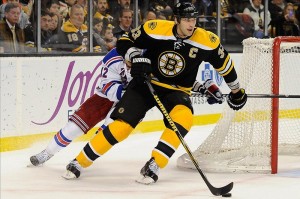Anyone with the basic math skills of a third grader can tell you that a team has a distinct advantage when it has more players out on the playing surface than its opponent. This is an advantage that the Boston Bruins have rarely capitalized on in the past decade, let alone the past season.
Power play efficiency won’t make or break a team entirely but if you’re a team on the cusp of making a playoff appearance, which the Bruins were last season, a handful of goals could make a huge difference. And when is a more opportune time to score a goal than on the power play?
The Woes
Since the lockout in 2004, the Bruins have broken the season power play percent threshold of 20% just twice. In the 2008-2009 season, their power play was ranked fourth in the league (23.6%) and third in the 2013-2014 season (21.7%).

In the former season, Zdeno Chara led the way with a career-high 11 power play goals and tied a career high with 17 power play assists. In the latter it was again Chara who led the way with 10 of the Bruins’ 74 power play goals and, an at the time unproven, Torey Krug chimed in with six goals and 13 assists on the man-advantage. Both are career highs for the now 24-year-old.
But, despite the two aforementioned seasons, the Bruins have lacked a sense of urgency on the man-advantage. As a team built from the crease out and based on a defense-first policy, the Bruins’ array of power play units have seemed almost nervous when handed the majority of possession for two minutes at a time. Defensemen circling back behind Rask to retrieve a cleared puck is far too familiar of a sight.
In the past ten seasons, the Bruins power play has been ranked in the top half of the league just three times. This past season, the Bruins’ power play was ranked 18th in the league with a success rate of 17.8%, scoring 38 goals on 213 opportunities. In a league where teams are committing fewer penalties every year (in the 2005-2006 season, for example, the Bruins had 411 power play opportunities), cashing in on the man-advantage is becoming even more crucial.
The Pros
Although execution has been a problem with the man-advantage for Boston, the Bruins still find themselves with a roster rich with scoring capabilities.
Centers

Boston has been graced with a number of centers who are skilled in the art of getting the puck to goal scorers. This past season, Patrice Bergeron led the team with 32 assists while Carl Soderberg was hot on his heels with 31. David Krejci, despite only making 47 appearances this season, had 24 assists. This coming a year after the 29-year-old assisted 50 of the Bruins’ 258 goals that season.
Although Bergeron and Krejci have seen their share of time on the Bruins’ power play in recent years, their offensive skill is unquestioned. They could still be part of the recipe in scoring with the man-advantage. And it’s nice to see that Soderberg has the ability to keep pace with as coveted a player as Bergeron.
The Swede
Loui Eriksson, after missing 21 games of the 2013-2014 campaign due to injury, scored 22 goals in a black and gold sweater this past season, six of which were on the power play. The highly skilled 29-year-old winger scored a total of 28 power play goals over the course of four seasons in Dallas (playing 79 games or more). Loui is a five-time 20 goal scorer who is definitely an upside to the Bruins’ power play.
Young Point Men
Torey Krug and Dougie Hamilton are two young offensive-defensemen who have begun making an impact on the ice for the Bruins.
Krug, who now has two full NHL seasons under his belt, has displayed his speed and skill at both ends of the ice – enough to ink him a one-year extension with the club. Krug’s ability to carry the puck through the neutral zone on the power play contrasts that of his fellow defensemen who at times have seemed far too reluctant to do so.
Hamilton has finally come into his own with a blooming confidence which no doubt had a stake in his 42 points this season. Half of his ten goals during the 2014-2015 campaign came on the power play, bringing his career total to nine. And as if that wasn’t enough upside for the Toronto, Ontario native, he’s only 21 years of age.
Fresh Blood
18-year-old David Pastrnak and 23-year-old Brett Connolly were both brought to the Bruins roster for their goal-scoring capabilities.

In the 46 games he played last season, Pastrnak notched ten goals and 17 assists. The 2014 first round pick out of the Czech Republic impressed critics and fans alike, likely solidifying his place in the lineup next season.
Connolly, who was acquired by the Bruins at the trade deadline last season, played just five games with the team after a Dennis Seidenberg slap shot fractured his finger in practice. Although the sixth overall draft pick in 2010 has yet to score a goal in a Bruins sweater, he bears an incredible wrist shot which will no doubt come into play on the man-advantage next season.
What’s Lacking
Although impressive, these highlights are not enough to solidify the Bruins with a sturdy power play in the foreseeable future. There still seems to be a piece to the puzzle that is missing: a lethal offensive weapon.
Newly appointed General Manager Don Sweeney has his work cut out for him with a team that missed the playoffs last season and has the league’s salary cap weighing down on its shoulders. But a goal scorer is a necessary acquisition for the Bruins this offseason if they want to find themselves with an effective power play during the 2015-2016 campaign. The 2015 NHL Entry Draft is just over a month away – a date that trades will surely begin to fly. And, seeing as though the free agent market is lighter than it has been in past years, trade would most likely be the route Sweeney takes if acquiring a goal scorer is indeed on his to-do list.
A solid power play unit won’t simply hand the Bruins the Cup next year, but it could very well be the difference between a playoff run and another early-April exit.